CONTINUING RESPONSE TO HURRICANE FLORENCE
ECU Department of Geological Sciences awarded four NSF RAPID grants
Even before Hurricane Florence hit North Carolina in September 2018, East Carolina University was preparing to respond. Four ECU research groups, led by faculty in the Thomas Harriot College of Arts and Sciences Department of Geological Sciences, have received funding to research the effects of Florence.
A combined $266,018 is coming from the National Science Foundation’s RAPID program, designed to allow for rapid response research related to natural disasters.
According to Dr. Stephen J. Culver, professor and chair of the department of geological sciences, there is a limit to the amount of funding that can be received through a RAPID grant.
“For one department to get four of these RAPID grants for one particular environmental event is really impressive — quite surprising — and reflects well on our department and on ECU,” Culver said.
The NSF tries to be very responsive to science needs associated with natural disasters including earthquakes, volcanoes, hurricanes, oil spills and land slides, he said. Therefore, NSF RAPID submissions and funding is higher during disaster years, and according to the ECU researchers, RAPID grants fund the critical work that has to be done right now.
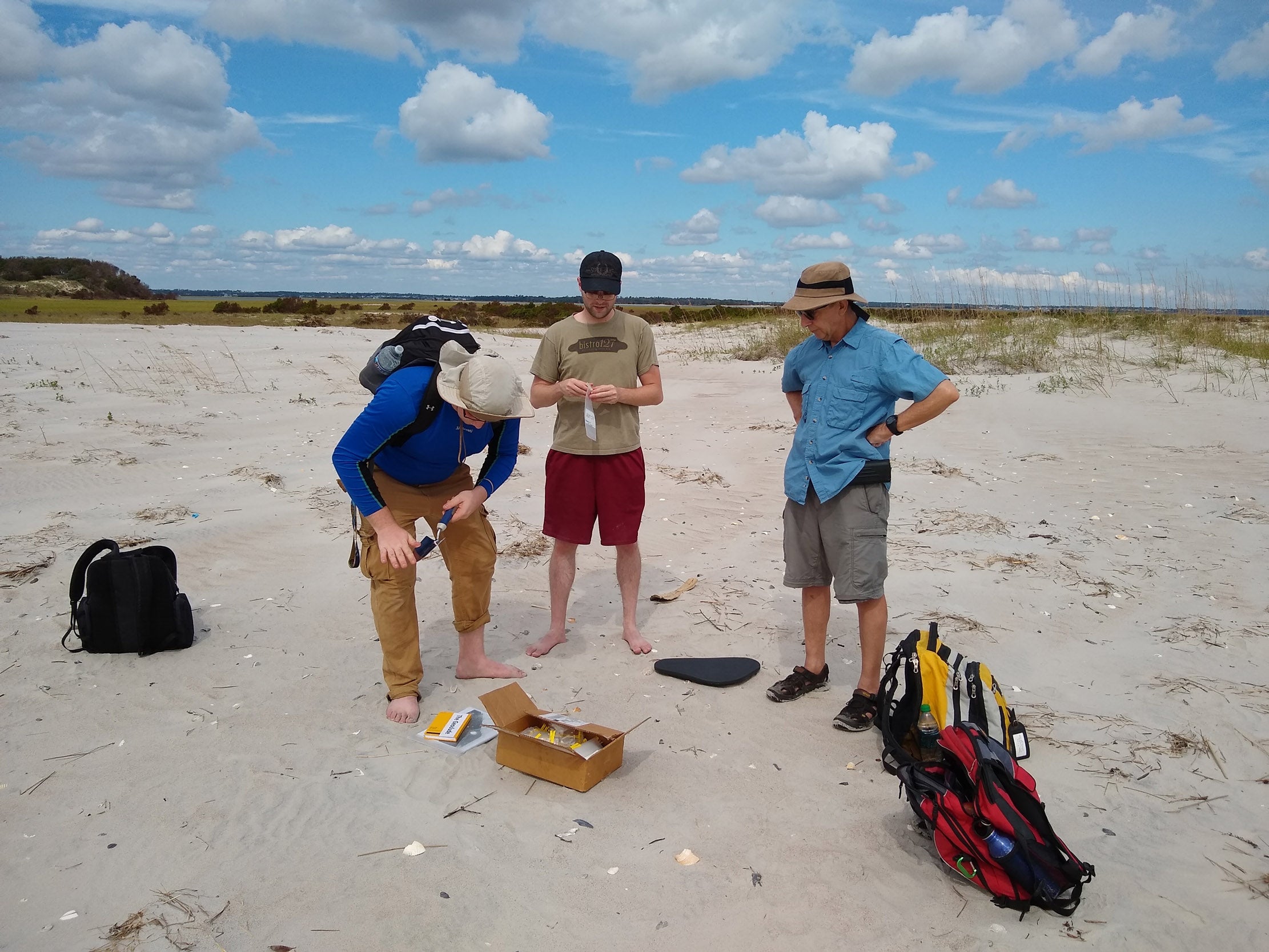
Graduate student Cody Allen (left) collects sediment samples at Hammocks Beach State Park for Mallinson’s RAPID research project. ECU student Taylor Miller and Dr. Steve Culver assist.
“The idea of these proposals is to get out and get data,” said Dr. David Mallinson, professor of geological sciences and primary investigator on one of the funded projects. “Another interesting thing is the broad spectrum of environments we are looking at, going from terrestrial, coastal and offshore — across the shelf and into the Gulf Stream — it’s pretty amazing we have the whole system covered.”
Mallinson submitted his research proposal just a couple of days after Florence made landfall and was informed only one day later that his research would be funded.
Mallinson and Culver, his co-investigator, are expanding upon research conducted by former graduate student Nina Shmorhun. Shmorhun mapped, collected and examined sediments along the shoreline around Hammocks Beach State Park. The objective of her thesis was to use the sediments and microfossils collected to identify specific types of environments and show the evolution of the coastal system, which is often used in oil and gas exploration.
Now, with the help of current coastal geoscience graduate student Cody Allen, Mallinson and Culver are using Shmorhun’s seafloor maps and identification of microfossils and sediments to compare against data being collected by Allen after Hurricane Florence.
“I am vey lucky to have the opportunity to work under Dr. Mallinson,” Allen said. “I am currently gaining experience in using geophysical equipment, micropaleontology and putting this information into context as it relates to my thesis.”
Mallinson’s team is going back to investigate how the coastline changed and how the storm impacted the inner shelf and beaches. They are looking to see if they can still identify the different environments based on previously collected samples, or if they were completely disrupted, which may give them equally important information on identifying past storm records.
“I think the most interesting aspect of the project is understanding the influence of high-energy events on sediment transport and how the data can be used in broader impacts to assist coastal communities with understanding sediment resources,” Allen said. “The scope of this project lends itself to various areas within geoscience and provides a broad range of experiences.”
Disappearing sand
Another part of Mallinson’s project includes examining the movement of sand along the shoreline.
“We know, along the beach at Hammocks Beach State Park, the shoreline receded — eroded — about 40-45 meters (130-145 feet). We lost a tremendous amount of sand, and it’s not clear where that sand went,” Mallinson said. “Did it move offshore? Did it move down the beach? Did it just get pushed through the inlets behind the islands?”
Water quality
Hurricane Florence hit at an opportune time for a new researcher at ECU. Not even one month after coming to ECU, Dr. Stephen Moysey, geological sciences professor and director of the recently established ECU Water Resources Center, gathered a team to look at the hydrological responses of the storm, particularly flooding impacts.
Along with co-investigators Dr. Hannah Cooper, assistant professor of geography, planning and environment; Dr. Michael O’Driscoll, associate professor with the Coastal Studies Institute; and Dr. Charlie Humphrey, associate professor of health education and promotion, Moysey flew in a researcher from Las Vegas, Nevada, who helped create maps depicting the extent of the flooding from Florence.
Moysey and his team also led a group of students who went out and collected water samples from the Tar, Neuse and Cape Fear rivers.
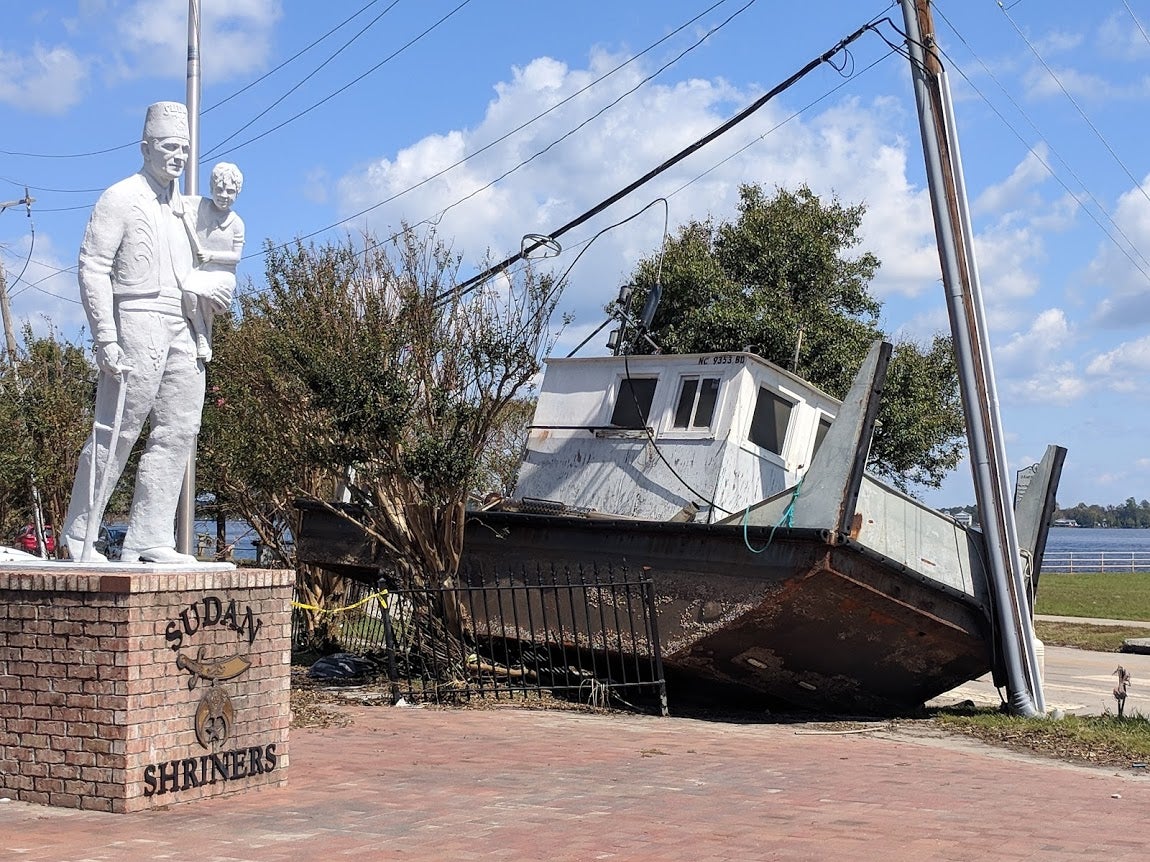
While examining the flooding impacts of Hurricane Florence, Dr. Stephen Moysey found this boat had been pushed ashore in New Bern.
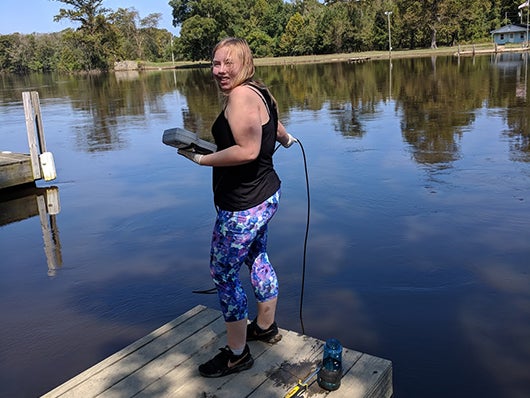
Shannon Briles, senior geological sciences major and lead coordinator for Moysey’s RAPID project, draws water samples from the Tar River.
“They are examining the water quality from the different rivers, seeing how these watersheds are responding differently and why,” Moysey said. “We are hoping to grow this into an ongoing project where students will continue sampling water quality across this part of the state.”
“I love filtering the water and seeing all of the sediments that can be pulled out of one small sample of river water. Seeing the changes that the rivers have gone through over time has also been very exciting and interesting,” said Shannon Briles, senior geological sciences major and the lead coordinator for Moysey’s water sampling project. “This is giving me a lot of lab experience that can be used on a resume when I start to look for jobs. I also like that I am able to use a lot of the new knowledge that I gain in my classes day-to-day.”
The third part of Moysey’s project includes citizen science, where people in the community contribute information about the impacts of the storm they witness in their areas. Moysey’s team began to reach out through social media immediately after Florence hit in an effort to gather data from the local community.
Sound sampling
Further out in the sound and into the Gulf Stream is where associate professor of geological sciences Dr. Siddhartha Mitra and his co-investigators are conducting their RAPID research. Mitra’s team consists of Dr. Erin Field, assistant professor of biology, and Dr. Reide Corbett, professor and director of the Coastal Studies Institute.
Mitra’s team was aware of Moysey’s river sampling and mapping project, and they wanted to examine how much material — sediment, and dissolved carbon and nutrients — was entering the Pamlico Sound and how much was escaping through the inlets, possibly affecting the Gulf Stream.
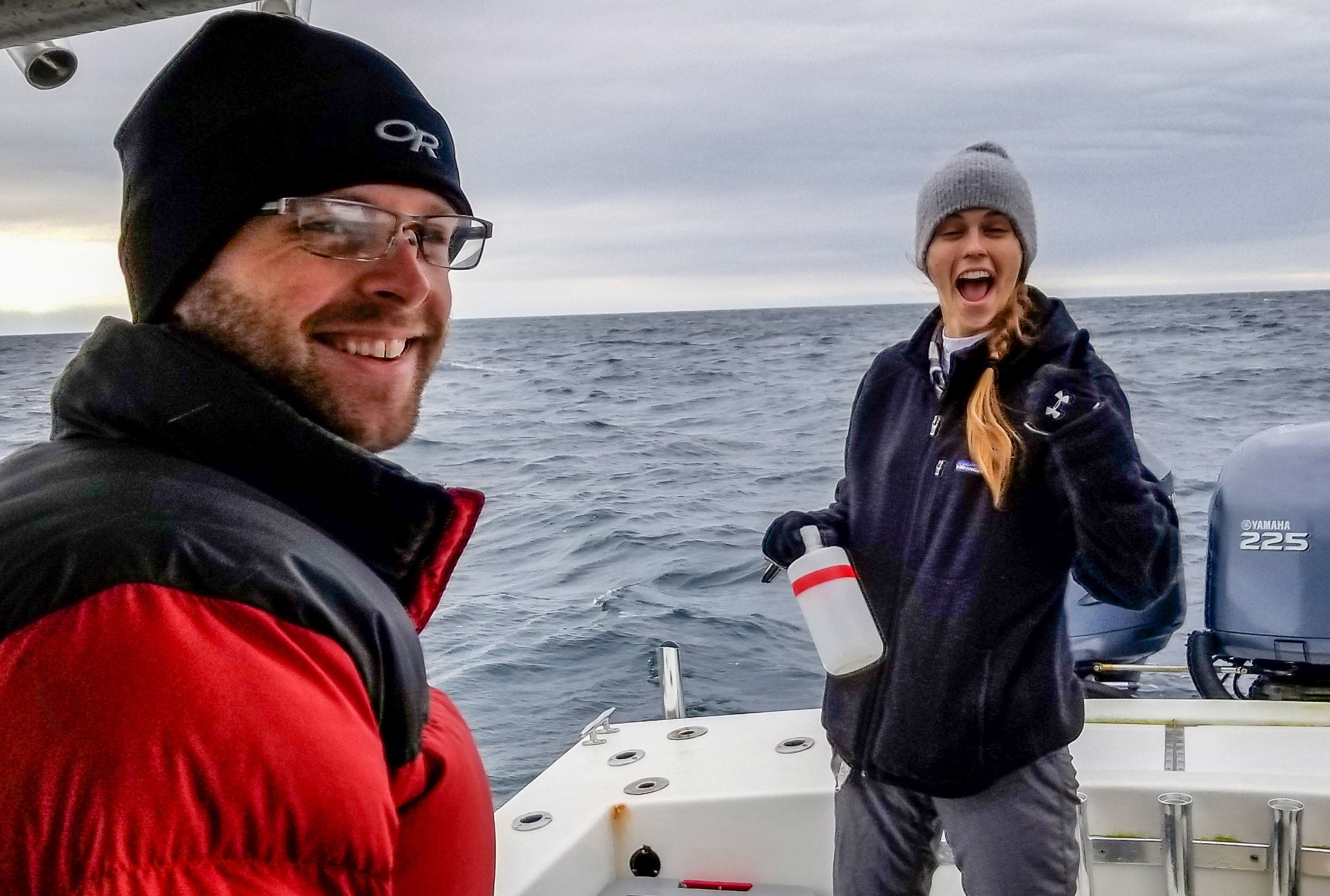
Graduate student Taylor Miller (left), Mitra’s student researcher, and Liz Mason (right), Corbett’s technician, give a thumbs up as they assist Mitra’s team in examining the sediment entering the Pamlico Sound after Hurricane Florence.
According to Mitra, the reason this is important is that the Gulf Stream, which is a huge conduit for energy and materials from the tropics to the poles, comes closest to land directly adjacent to North Carolina and the Outer Banks.
“Our goal is to find out how much of the Carolina watershed and organic matter are making it into the Gulf Stream and affecting the ecosystem,” Mitra said. “If there is going to be any type of conduit and connection between sediment and dissolved material, it was going to happen adjacent to North Carolina.”
His team’s hypothesis is that nutrients, organic matter and bacteria from land were pulsing through the sound and inlets, and if they got into the Gulf Stream, they may potentially be switching the Gulf Stream from a net autotrophic system (taking in carbon dioxide) to a net heterotrophic system (pushing out carbon dioxide).
“Essentially, you are taking a system where microbes are used to processing material. Now you are giving them a feeding frenzy of new material. You are putting in microbes that are very hyperactive and used to breaking down terrestrial materials, and you are giving them this juicy food in the Gulf Stream. So it’s possible you are sending restoration through the roof making carbon dioxide,” Mitra said.
“Dr. Mitra has trained us well and makes sure we have a comprehensive understanding of the work we are doing and its impact,” said Anne Marie Lindley, junior geological sciences major and one of Mitra’s student researchers. “After graduation, I want to go into hydrology. This research has helped me better understand water chemistry as well as how water is impacted by major meteorological and terrestrial events.”
Mitra’s team has gone out on three cruises. They plan to compare this information to baseline conditions once the rougher winter season passes.
Farmland impacts
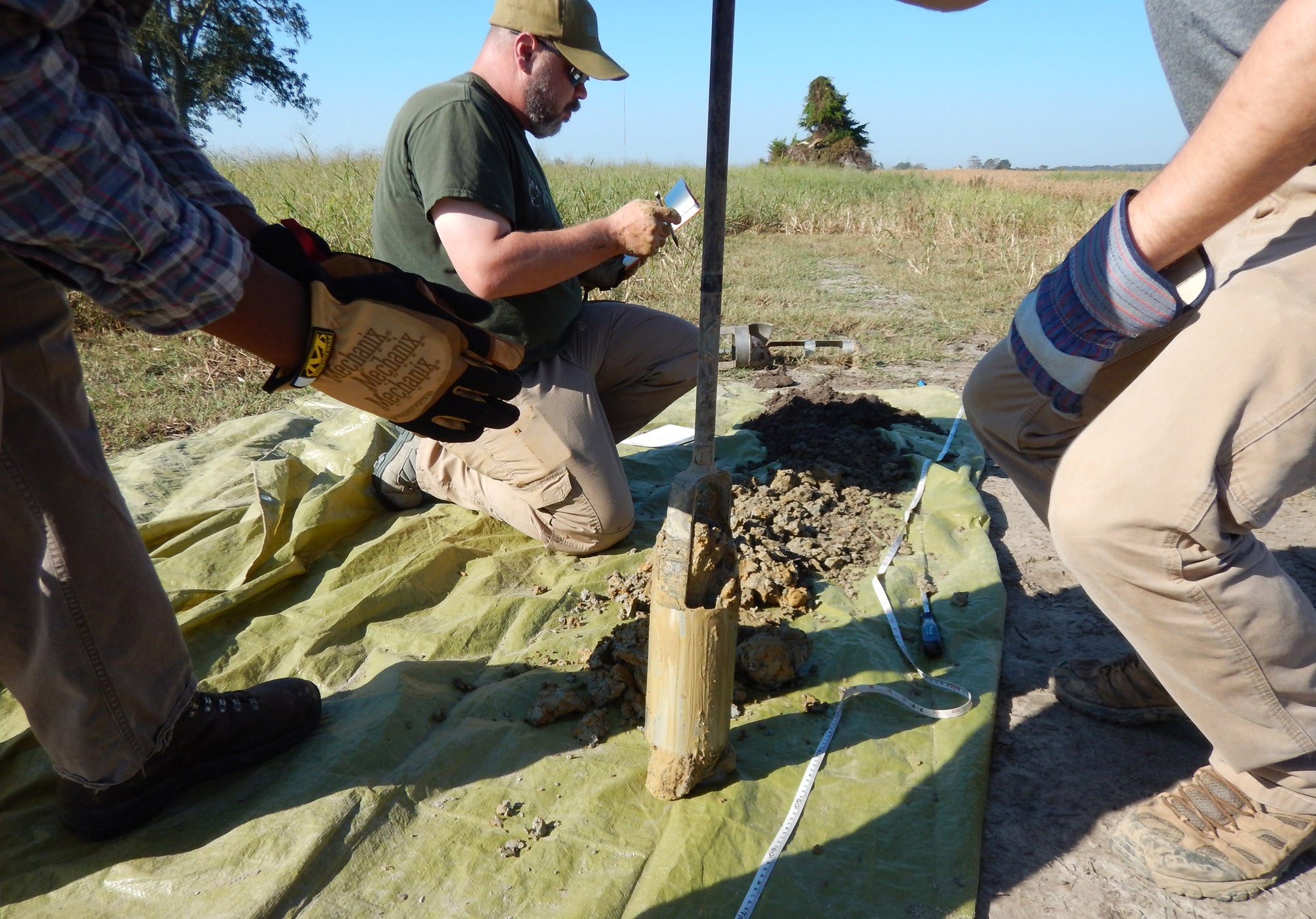
Graduate student Jon Gullet records data from soil collected in one of three counties for Manda’s RAPID grant. The team is trying to help determine what is driving the process of increased salinity in the soil in eastern North Carolina farms.
Circling back to the mainland, associate professor of geological sciences Dr. Alex K. Manda is researching how Florence and previous storms may be impacting eastern North Carolina farmers and their crops.
According to Manda, the state extension office had been receiving calls from farmers in eastern North Carolina complaining about potential intrusion in their fields. The farmers were seeing patches in the fields that were not growing or leading to poor crop yield. The extension office would sample the soil and were identifying high salt content.
This is where Manda initially got involved.
“It’s a big problem for the farmers. We need to figure out what to do. In order to do this, they need to understand how and why the problem is occurring in the first place,” Manda said.
Manda and his student researchers are trying to determine what is driving the process of increased salinity in the soil. Is it coming from the sound, through groundwater, from surface waters (canals, drainage ditches), or storm surge events created by hurricanes? If it is coming from storm surge, why is it that some farms are showing effects months or years later?
Manda’s goal is to test the soil and determine which of these are more likely to be the cause of the increased salinity in patches of land, and Hurricane Florence has given him the perfect opportunity to test whether storm surge and hurricanes are causing an effect.

Graduate student Kyle Prock (left) and Manda extract a soil sample from a field in Hyde County.
“After a hurricane there is an immediate need to sample these sites so we can track the movement or potential movement of and concentration of salts in the subsurface,” Manda said.
The exact number of farmers who have been affected by this is not known, but in terms of counties, Manda said a lot on the east coast has been affected, including Hyde, Pasquotank and Camden counties — the three sites he and his students are investigating — but others have reported adverse affects.
“I am elated to have the opportunity to assist Dr. Manda with this research, especially knowing that the process we complete and the data we compile can better serve the needs of the local farmers who are impacted,” said Jon Gullet, a graduate student majoring in geological sciences with a concentration in hydrogeology. “I get to go out to the field and collect real-time data by multiple observational methods, record it and then bring it back to the lab to be analyzed. The experience I have attained from this has been invaluable in helping me mature as a hydrogeologist.”
All four ECU teams were pleased that their research was funded by the NSF RAPID program, and they are excited to continue their work and assist others.
“Everyone has been very collaborative and eager to exchange information related to this natural disaster,” Mitra said.

Graduate student Cody Allen (center) collects samples along the shoreline at Hammocks Beach State Park. Allen is working on Mallinson’s team to investigate how the coastline has changed after Hurricane Florence. Also pictured are ECU student Taylor Miller (left) and Dr. Steve Culver (right).
